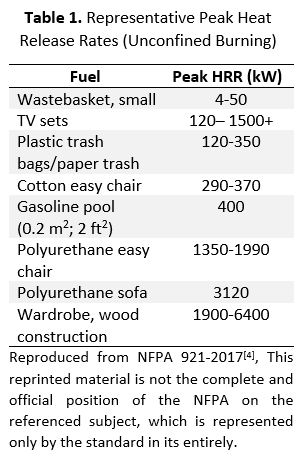What Does Fire "Size" Mean?

Due to their high surface area to volume ratio and relatively large mass, dry Christmas tree fires can ignite and grow quickly to release large amounts of heat. Table 1 presents representative peak heat release rates (during unconfined burning) of several items that can be found at home.
Fire ‘size’ is measured in terms of the fire’s Heat Release Rate (HRR) in kilowatts (kW). As shown in the video below, fire development can be described by changes in HRR versus time as a fire burns. After ignition, typical fire development under well-ventilated conditions (where there is sufficient oxygen for the fuel to be completely burned) occurs in three stages:
Growth: When fire size (HRR) increases as more flammable material becomes involved in the fire
Fully Developed: When fire size (HRR) remains approximately constant (steady burning)
Decay: When fire size (HRR) decreases as the fuel burns out or the fire is extinguished
Video: Why You Should Water Your Christmas Tree. Properly maintaining a cut Christmas tree is important to retaining a high moisture content in the branches and needles of the tree. This can help to limit ignition likelihood, fire growth rate, and peak fire size.
Fire development is a function of many factors including: fuel properties and quantity, room ventilation and geometry (volume and ceiling height), location of fire, and ambient conditions (e.g. temperature, availability of fresh air).
You can compare data in the video above to previous experimental measurements[5, 6] and detailed simulations[7] of Christmas tree burning behavior. Detailed descriptions of several key terms – e.g. temperature, heat, flashover, and heat release rate – presented on this page are available at the NIST Fire Dynamics page: https://www.nist.gov/fire-dynamics.
______________________________
[4] NFPA 921: Guide for Fire and Explosion Investigations, 2017. Edition. In NFPA National Fire Codes Online. Retrieved from http://codesonline.nfpa.org October 25, 2017.
[5] Stroup, D.W., DeLauter, J.L., Roadarmel, G., “Scotch Pine Christmas Tree Fire Tests,” NIST Report of Test FR 4010, National Institute of Standards and Technology. December 1, 1999. https://www.nist.gov/publications/scotch-pine-christmas-tree-fire-tests-report-test-fr-4010
[6]Madrzykowski, D., “Impact of a Residential Sprinkler on the Heat Release Rate of a Christmas Tree Fire,” NISTIR 7506, National Institute of Standards and Technology. May, 2008. https://www.nist.gov/publications/impact-residential-sprinkler-heat-release-rate-christmas-tree-fire
[7] Mell, W., Maranghides, A., McDermott, R., Manzello, S.L., “Numerical Simulation and Experiments of Burning Douglas Fir Trees,” Combustion and Flame 156: 2023-2041. 2009. https://doi.org/10.1016/j.combustflame.2009.06.015. Accessed September 3, 2025.
Contacts
-
(301) 975-6887

